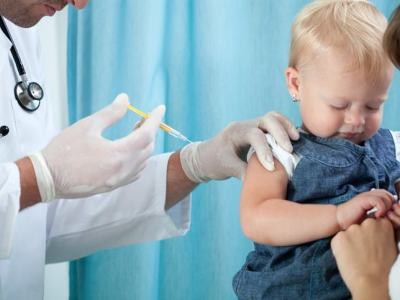Oct 3, 2008 (CIDRAP News) – A flu vaccine manufacturer's decision not to build a US facility has highlighted the perpetual mismatch between flu-shot supply and demand—and the reality that the mismatch may undermine plans for pandemic flu vaccines.
On Tuesday, Solvay Pharmaceuticals Inc. of Marietta, Ga., announced that it was canceling plans to build a US flu-vaccine manufacturing plant, a $386 million project that Birmingham, Ala., and Athens, Ga., have been competing for. The plant would have made both seasonal and pandemic flu vaccines—but at just about the moment when a final site selection was expected, the company announced that the economics of the two-year-old deal no longer make sense.
Solvay Pharmaceuticals is the US subsidiary of a Brussels-based conglomerate that makes plastics, industrial chemicals, and pharmaceuticals, including an egg-based flu vaccine called Influvac that is sold in Europe and Canada but not in the United States. Solvay also makes flu vaccine by cell culture, a newer technique that does not depend on chicken eggs; the vaccine is made in the Netherlands and has been approved for sale there, though the plant where it is made is still undergoing validation.
Establishing flu-vaccine manufacturing within the United States, especially cell-culture manufacturing, is a dearly sought goal of the federal government. Only one of the five manufacturers that sell into the US seasonal-flu market makes its vaccine within US borders. That has led to fears that, if a pandemic began, vaccines would not reach the US, because the countries where companies are based might hold back whatever is made there. The government has also been eager to develop domestic cell-culture manufacturing because it is not dependent on egg production, is not imperiled by viruses such as avian influenza H5N1 that are lethal to chickens and chicken eggs, and can be scaled up rapidly if necessary.
Solvay received big HHS grant
In May 2006, the Department of Health and Human Services granted more than $1 billion to five pharmaceutical firms to develop cell-culture technology and manufacturing capacity within the United States. Solvay, one of the five, received $298 million for "the development and testing of new influenza vaccines including pandemic vaccines that are produced using cell-based technology and the development of a master plan to manufacture, formulate, fill and package annual and pandemic influenza vaccines in a new US-based facility," the company said in a press release at the time.
But while the grant covered development and design costs for the new plant, it did not in the end cover enough of the capital costs to make the facility worthwhile, Solvay spokesman Neil Hirsch said in an interview.
"There are many drivers for us making the decision to not move forward with the US facility," Hirsch said. "One of them has to do with the fact that the government was proposing a 40 to 60% cost-sharing, whereby the government would reimburse 40% of all costs for the facility rather than a full reimbursement."
In a normal business sector, bearing only two-thirds of the risk of a product line might seem like a good investment. But flu-vaccine manufacturing is not a normal business. While federal health authorities have labored to convince Americans to take the seasonal flu shot, millions of doses go unsold each year: 27 million of the 140 million made for the 2007-08 season, for instance, and 18 million of the 121 million made for the 2006-07 season. This year, 148 million doses are anticipated.
While demand for the shot has risen slowly each year, it still remains far below health authorities' hoped-for goals. The CDC announced last week that the highest rate of usage is 72%, among adults over 65, for whom the shot is universally recommended. But rates in younger adults range from 23% among healthy 18- to 49-year-olds to 54% among 50- to 64-year-olds who have medical conditions putting them at high risk for flu–related illness. And usage rates among children are even lower, from 22% among 6- to 23-month-olds to 16% among 2- to 5-year-olds.
While it has not been spelled out, the uncertainty of the market for flu vaccine and the possibility that it is already overcrowded were clearly factors in Solvay's decision. "When we started this process several years ago, the seasonal flu vaccine market was different," Hirsch said, referring to years when fewer manufacturers sold in the United States. "That landscape has changed."
And a further factor may be the reality that, unlike its competitors, Solvay makes only flu shots. It does not make other vaccines that could make up for poor flu-shot sales, or that could be made in the new facility if flu-shots sales went awry again—possibilities that made the decision to fall back on its Amsterdam manufacturing plant seem less risky.
Hard commercial realities
"This should not be a surprise," retired academic and pharmaceutical company executive Dr. David Fedson, an acute observer of the flu-vaccine market, said in an interview. "It indicates how fragile the notion you can expand vaccine supply is, and it indicates the hard commercial realities that drive vaccine-manufacturing companies."
Nevertheless, the Solvay decision deprives the United States of a domestic source for pandemic flu vaccine if or when a global outbreak begins. And by refusing to offer supply into an uncertain market, the company is challenging the central assumption behind US and global planning for pandemic-vaccine capacity: that demand for seasonal vaccine will provide companies with a rationale for making more vaccine than they now do.
Federal health officials have asserted many times that demand will boost manufacturing capacity to the level needed for a pandemic. To reach that level, the World Health Organization's 2006 "Global Pandemic Influenza Action Plan" calls for countries to boost their flu-shot usage to 75% of their populations, including countries where seasonal vaccine has never been used.
No lack of warning voices
Numerous voices, though, have warned that this approach is unworkable. In 2005, David Johnson, director of scientific and medical affairs for Sanofi Pasteur, the only company making flu shots in the continental United States, warned the federal National Vaccine Advisory Committee of manufacturers' discomfort with speculative "at risk" manufacturing. Britain's Royal Society said in 2006: "It is not commercially viable for the vaccine industry to commit the necessary resources to scale up production in advance of a pandemic when there is no existing market, the threat of a pandemic may be years away and the risk in any single year may be considered to be low."
And apparently anticipating the Solvay decision, biotech industry members writing in the journal BioPharm International said last year: "In the US market alone by the year 2010 there could be a surplus capacity resulting from 'building for demand' for pandemic preparedness but 'suboptimal utilization' based on significantly lesser demand for seasonal vaccines."
Solvay spokesman Hirsch confirmed that the company intends to pursue licensure of its Dutch-made seasonal vaccine in the United States, though he declined to provide details in deference to Food and Drug Administration policies. But by canceling its US plant, Solvay appears to have provided clear warning to federal planners that protecting the United States against a pandemic requires vaccine manufacturers to take substantial risks—and that given the unreliable US market and the hard realities of the global economic downturn, those risks may be something manufacturers can no longer afford.
See also:
Solvay press release on HHS grant
http://www.businesswire.com/news/home/20060504005739/en/Solvay-Pharmaceuticals-Awarded-298-Million-Five-Year-Contract
Overview of HHS pandemic vaccine plans in new GAO report:
http://www.gao.gov/new.items/d08671.pdf
May 13 CIDRAP News story "Flu experts try to ensure record vaccine doses get used"
(Overview of flu-shot uptake problems)
WHO Global Pandemic Influenza Action Plan
http://www.who.int/csr/resources/publications/influenza/CDS_EPR_GIP_2006_1.pdf
Johnson in NVAC minutes, Feb 8-9, 2005:
http://www.dhhs.gov/nvpo/nvac/documents/NVAC20050208Minutes.doc
Royal Society's Pandemic influenza: science to policy.
http://royalsociety.org/Pandemic-influenza-science-to-policy/
Thomas A, Guldager N, Hermansen K. Pandemic flu preparedness: a manufacturing perspective. BioPharm Int 2007 Aug (supp) [Full text]



















